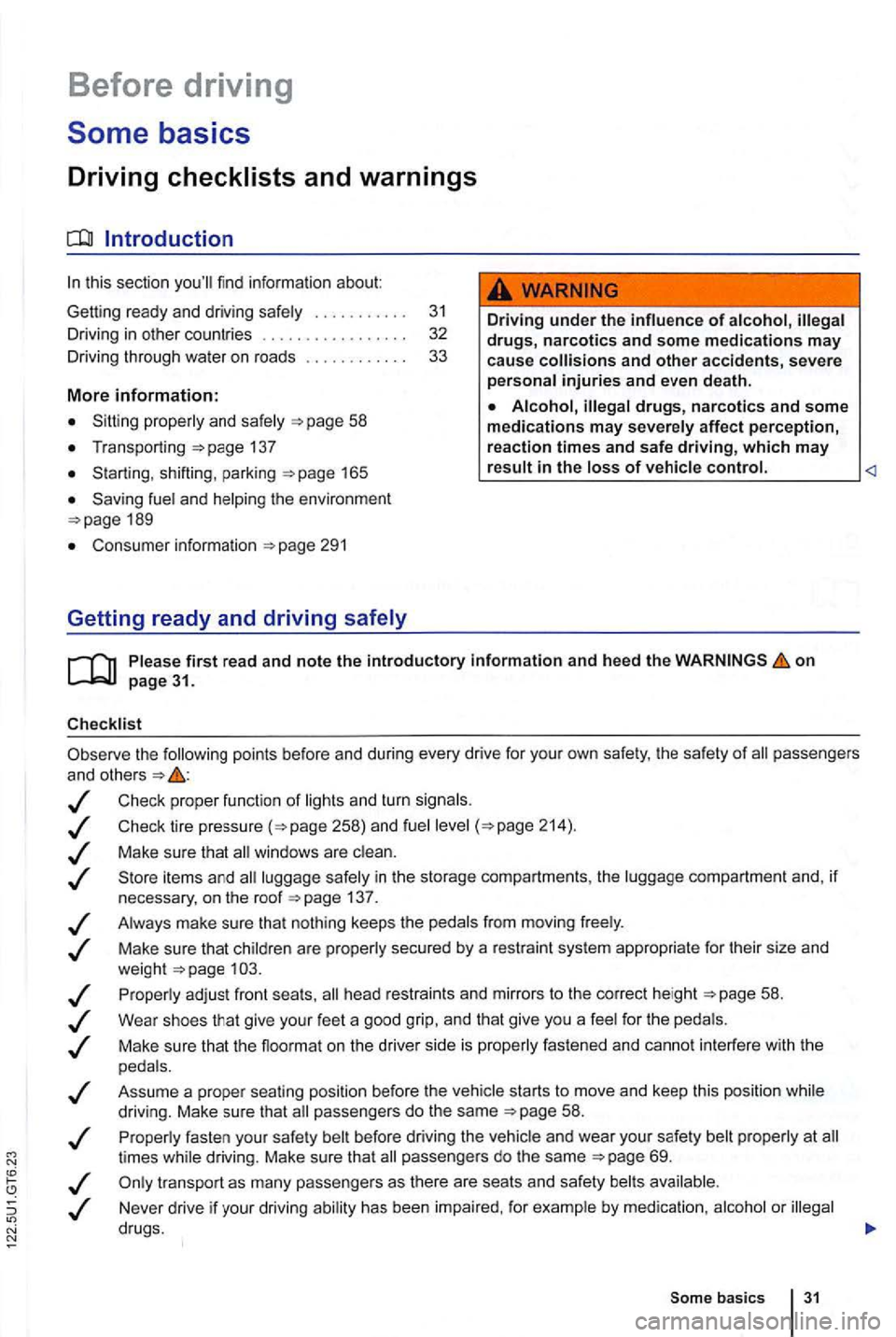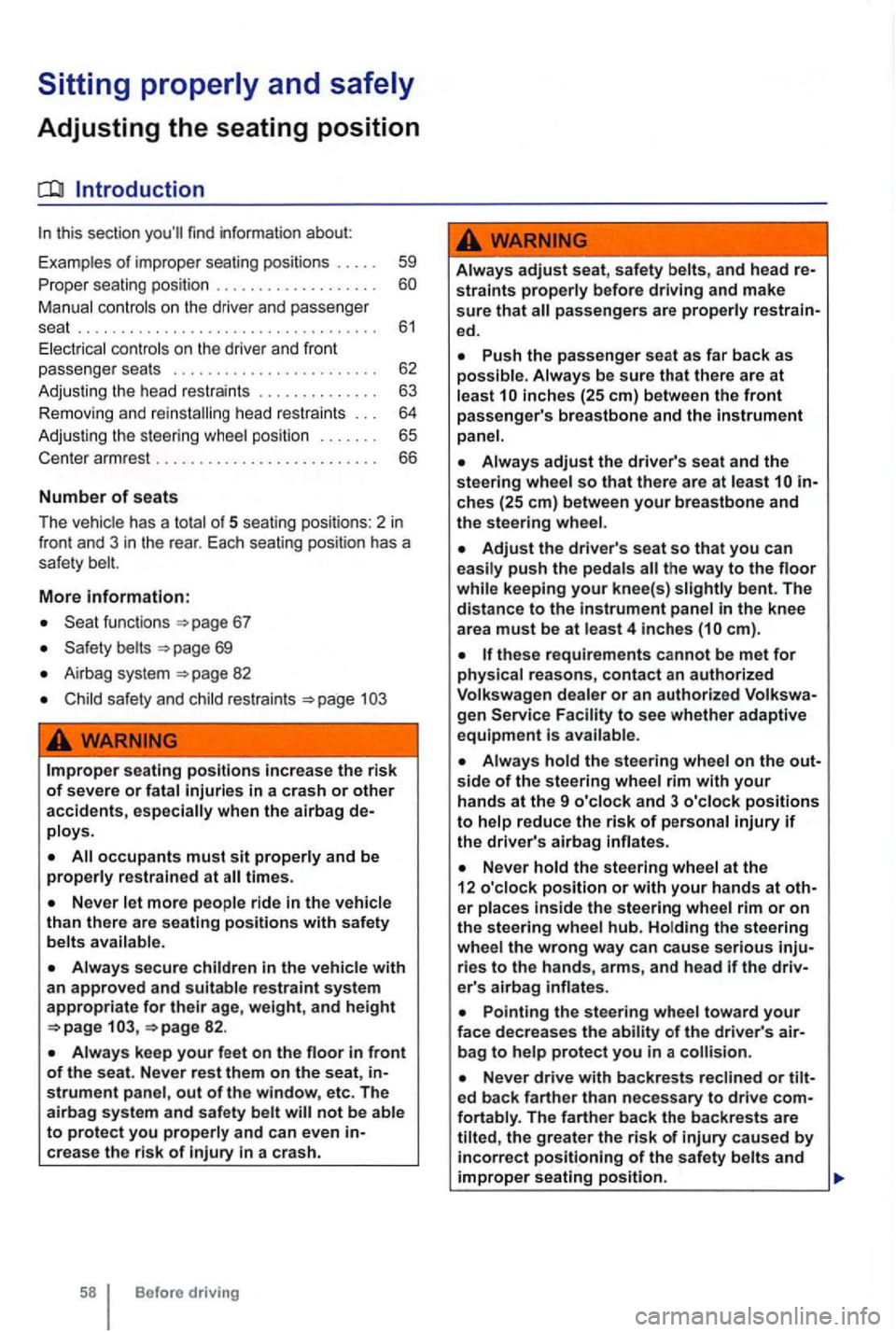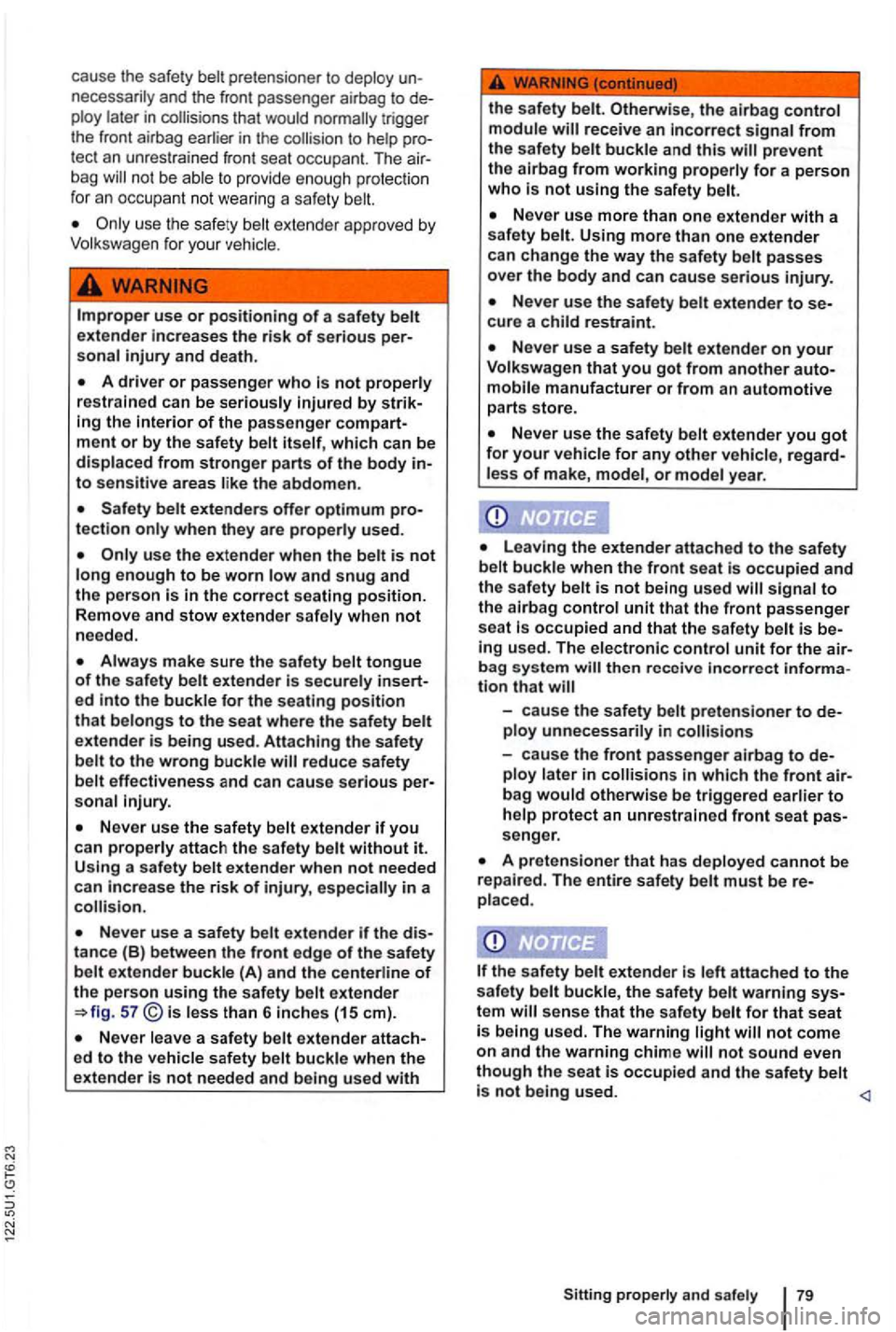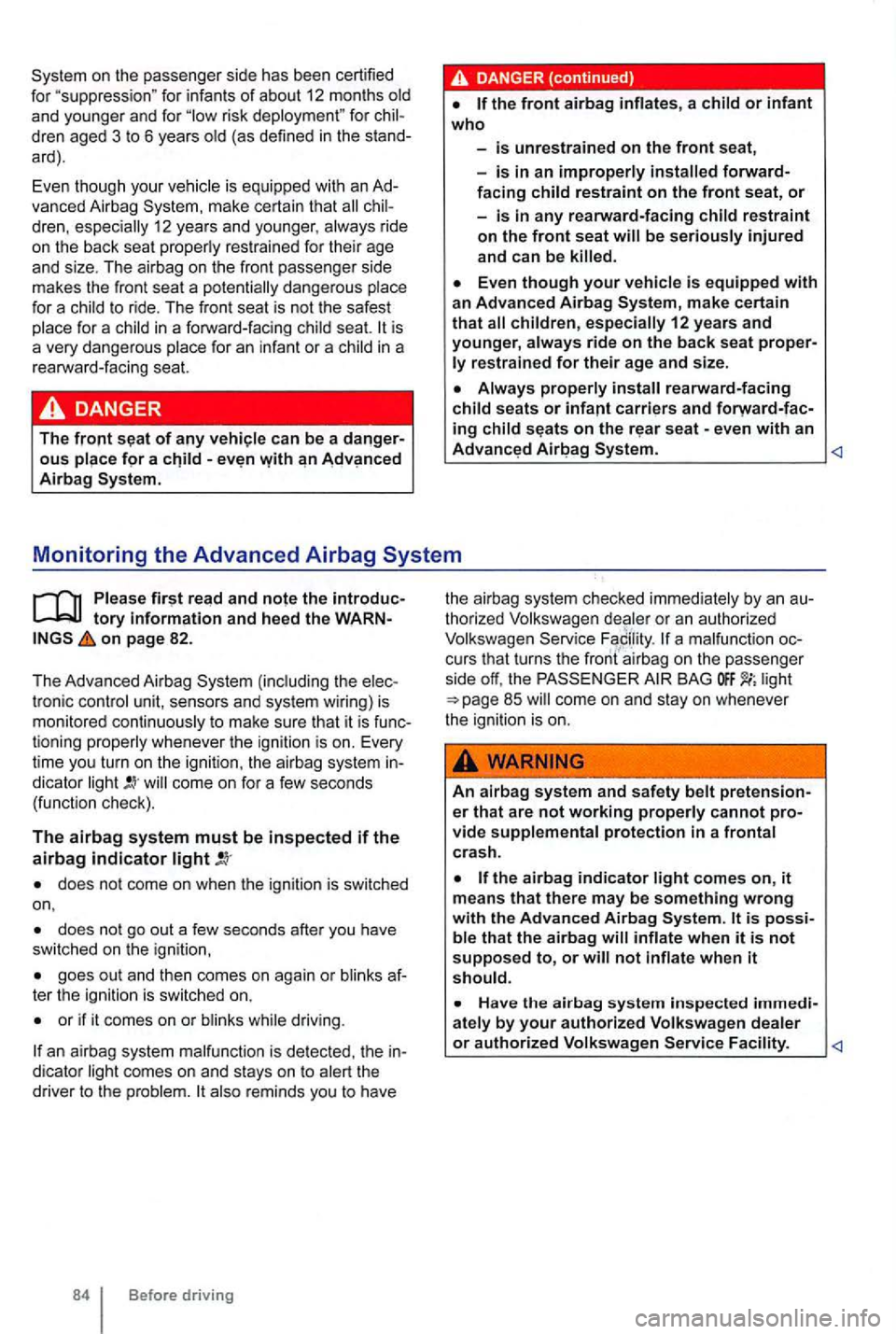2010 VOLKSWAGEN GOLF child seat
[x] Cancel search: child seatPage 130 of 516

Before driving
this sectio n yo u'll find infor ma tion about
Gett ing ready and driving safely . . . . . . . . . . . 3 1
Driving in other countr ies . . . . . . . . . . . . . . . 32
Driving through
water on ro ads . . . . . . . . . . 33
More information:
S tarting , shift ing, pa rking 1 65
189
Consumer information
Driving under the influence of alcohol,
on
the following points be fore and during every drive for you r own safe ty, the safety of passengers
and other s
Check proper functio n of lights and turn signa ls .
Check tire pressu re
258) and fuel 214) .
Make su re that win dows are .
137 .
Always make sure tha t nothing keeps th e pedals from moving freely .
Make sure that children are properly sec
ured by a rest raint sys tem appropriate for their size and
weigh t .
Proper ly ad just front seats , head restraints and mirrors to the correct height
give your feet a good grip, and that give you a feel for the peda ls .
M ake sure that the floormat on the drive r side is properly fastened and canno t interfere with the
peda ls .
Assume a prope r sea ti
ng posi tion before the vehicle starts to move and keep this positio n whil e
driving. Make sure that passe ngers do the same 58 .
P roper ly fasten your safe ty bel t before
driving the vehic le and wear you r safety belt properly at times while driving. Make sure that passe ngers do the same
or
Som e basics 31
Page 157 of 516

Adjusting the seating position
Introduction
this section find inf ormation about:
Examp les
of improper seat ing pos itions . . . 59
Pr ope r seating position . . . . . . . . . . . . .
Manual contr ols on the driver and passe nger
seat . . . . . . . . . . . . . . . . . . . . . . . . . . . . . . . . . . . 61 Ele ctrica l co ntr ols o n the driver and front
passenger seats . . . . . . . . . . . . . . . . . . . . . . . . 62
Adj ustin g
the head restra ints . . . . . . . . . . . . . 63
R emoving and re in stalling head restraints . . . 64
Adj usting the stee
ring whee l position . . . . . . . 65
Cen te r armrest . . . . . . . . . . . . . . . . . . . . . . . . . . 66
Number of seats
Th e vehicle
has a t otal of 5 seat ing posit ions: 2 in front and 3 in the rea r. Eac h seating pos ition has a
safety belt.
More information:
funct ions 67
page 69
Ai r ba g syste m 82
safety and child restraints
WARNING
Improper seat ing pos itions increase the risk of severe or fatal injuries in a crash or other accidents,
times .
Never
Always secure children in the vehicle with a n approved and suitable restraint system appropriate for their age, weight, and height 82 .
Always keep your feet on the in front of the seat. Never rest them on the seat,
Always adjust seat , safety belts, and head straints properly before driving and make sure that
inches (25 em) betw een the front pa ssenger' s breastbone and the in strument panel.
ches (25 em) between your breastbone and the steering wheel.
Adjust the driver's seat so that you can push the pedals while keeping your knee(s) slightly bent. The
di stance to the instrument panel in the knee
a rea must be at least 4 inche s
these requirements cannot be met for physical reason s, contact an authorized
Volk swagen dealer or an auth orized gen Facility to see whether adaptive equipment is avai la bl e.
Always hold the steering wheel on the side of the steering wheel rim with your hands at the 9 o'clock and 3 o'clock positions to help reduce the risk of personal injury if the driver's airbag inflates .
Never hold the steering whee l a t the
12 o'clock position or with your hands at e r places inside the steering whee l rim or on the steering wheel hub. Holding the steering wheel the wrong way can cause serious rie s to the hand s, arm s, and head if the
Pointing the steer ing whe el t oward your face dec reases the of the driver's bag to h elp protect you in a
Never drive with backrest s reclined or ed back farthe r than necessary to drive
Page 166 of 516

this section find information about:
. . . 67
More information:
Adjusting the seating position 58
69
Airbag system page 82
safety and restraints
Outside mirrors 134
the cente r heating for front seats.
on page 67.
When the igni
tion is sw itched on, the front seats
can be that
wa rm the seat backrest and cush ion .
Do not use the seat heating
if any of the cond itions
the sea t is not being used.
on the front
passenger seat.
there is a or seat cover on the front
passenger seat.
the seat is damp or wet.
(25 or more .
use of seat adjustment controls can
cause severe personal injuries.
passengers, especially
children, are properly seated whenever the
44
button. heating is sw itched on to
m aximum.
Adjust the hea ting
re-the desired
heating
the button re
peatedly indicator
s uff ering from a of perce ived pain
or a
The use of seat heating by persons with these conditions time to and may
never
take breaks and get out of the trips. your docto r fo r advice rega rding your specific con-
dition.
Sitting a nd 67
Page 168 of 516

find informati on about:
Fro nt al
Properly worn safety fective means of reducing the risk of serious injury
and death in a or othe r accident.
D amage to sa fety belts reduces their
tiveness and increases the risk of se rious personal
i nj ury and death whenever the vehicle is being
used .
Check the conditi on of
a safe ty belt shows damage to webbing , ings, retracto rs or buckles . have the safety belt
More information:
Adjusting the seating posit io n
Airbag system
Child safety and child restraints 103
Parts , access ories, repai rs and modifications
Properly worn safety belts are the single most effective means of r educing the risk of serious injury and death in a collision or er accident. For this reason , always wear your safety belt properly and make sure all
pa ssengers wear their safety belts properly as well whenever the vehicle
The driver must always make sure that
hicle. Thi s applies even when just driving around town. Therefore, always wear your safety belts and make sure that everybody in your vehicle is properly restrained.
Always secure children
Always fasten safety belts correctly before driving off and make sure that all passengers
are properly re strained .
Never attach the safety belt to the buckle of another seat. Attaching the safety belt to the wrong buckle will reduce safety belt fectiveness and can cause serious personal injury.
cle is moving. Doing so will
small children, into any single safety belt.
Never wear belts over rigid or breakable objects in or on your clothing, such as glasses, pens, keys, etc., as these may cause injury.
layers of heavy clothing (such as
a coat worn over top of a sports jacket) may with proper. positioning of the safety belt and reduce the overall effectiveness of the system .
Never use comfort clips or devices that create slack in the shoulder belt. However,
s pecial clips may be required for the correc t
u se of some child res traint systems.
Page 174 of 516

The switchable locking feature makes a sound when the safety a// the way out. When ever a child restraint is with a safe ty belt , the safety belt must be locked so
that the safe ty webbing cannot unreel 103, Child safety and child restraints. ac
tive, deactivate t he locking feature before us ing the safety belt to restrain a person without a chi ld re
straint system .
Fastening safety belts
Always buckle your safety belt before driving.
Adjust the front seat and head restraint correct
ly
Make sure the seat backrest of the rea r sea t
benc h is in an upright position and sec urely latch
ed in place be for e using th e sa fety
Hold the safety belt by the tongue and
51.
on the safety to make sure that it is securely latche d in the buckle .
Unfastening safety belts
Unfasten safety only when the vehicle is not
Press the red button on the buckle 52.
T he buckle tongue is ejected .
Let the belt wind up on the retractor as you
gu ide the belt tongue to its stowed position to help
preve nt th e safety belt from twisting an d to help
avoid damage to the interior trim.
Im
properly positioned safety belts can cause serious p ersonal injury or death in a n acci
dent.
Safety belts offer optimum protection only when the seat backrest is upright and belts are correctly positi oned on the body.
slips from the stronger parts of the body sensitive are as like the abdomen.
Page 178 of 516

cause the safe ty belt pretensioner to deploy u n
necessar ily and the front passe nger airbag to de
p loy late r in that would
not be ab le to p rovi de enou gh pro tection
f or an occupant not wearing a safety be lt.
use t he safe ty b elt ex te n de r app ro ved by Volkswage n for your veh ic le .
Im
proper use or positioning of a safety belt extender increases the risk of serious per
sonal injury and death .
A driver or passenger who is not properly restrained can be seriously Injured by strik
Safety belt extenders offer optimum protection only when they are properly used.
use th e ex te nder when the belt is not tong enough to be worn tow and snug a.n.d the person the correct seating
Always make sure the safety belt tongue of the safety belt extender the buckle for the seating position that belongs to the seat where the safety belt extender is being used. Attaching the safety belt to the wrong buckle will reduce safety
belt effectiveness and can cause serious per
sona l injury.
Never use a safety belt extender if the distance (B) between the front edge of the safety belt extender buckle (A) and the centerline of the person using the safety belt extende r less than 6 inches (15 em).
Never leave a safety belt extender attached to the vehicle safety belt buckle when the
extender is not needed and being used with the
safety belt.
the airbag control module will receive an incorrect signal from the safety belt buckle and this will prevent
the alrbag from working properly for a person who is not usi ng the safe ty belt.
Never use the safety belt extender to se
cure a child restraint.
Never use the safet y belt extender you got for your vehicle for any other vehicle, regardless of make, model, or model year.
beused. The elect ronic control unit for the air
bag system will then receive incorrect informa
tion that will
- cause the safety belt pretensioner to deploy unnecessarily in collisions
-cause the fron t passenger alrbag to deploy la ter in collisions
A pretens ioner that has deployed cannot be
repaired . The entire safety belt must be re
placed .
being used. The warning
Page 183 of 516

for infants of about 12 months old
and younger and for risk deployment" for
dren, especially 12 years and younger , always ride
on the back seat proper ly restrained for th ei r age
and size. The airbag on the front passenger side
makes the front seat a potentially dangerous place
for a child
to ride. The front seat is not the safest
place for a child in a forward-fac ing child seat.
of any can be a
restraint
on the front seat be seriously injured and can be
make certain that children, 12 years and
younger, always ride on the back seat
on the
on page 82.
The Advanced Airbag (including the tronic control unit , sensors and system wiring ) is
monitored continuously to make sure that it is
dica tor come on for a few seconds
(function check).
The airbag system must be inspected if the airbag indicator
does not come on when the ignition is switched
o n ,
does not go out a few seconds after you have
sw itched on the ignition,
goes out and then comes on again or blinks ter the ignition is switched on.
or if it comes on or blinks while driv ing.
dicator also reminds you to have
84 Before driving the
airbag system checked immediately by an
thorized a malfunction curs that turns the front airbag on the passenger
side off, the BAG Off light come on and stay on wheneve r the ignition is on.
er that are not working properly cannot vide supplemental protection in a frontal
crash.
the airbag indicator light comes on, it means that there may be something wrong with th e Advanced Airbag is ble that the airbag not inflate when it should.
Facility .
Page 184 of 516

Fig. 58 BAG lig ht o n the instrument
on page 82 .
T he
BAG
on the passenge r side has been
turned off by the electronic con trol unit.
th e bulb for the BAG light burns out, th e airbag indicator come on and signal a malfunction in
the Advanced Airbag
no ger be possible to use the BAG light to make sure that th e bag on/off status is correc t fo r the occupant on the
front passenger seat. Have the air bag system spected immediate ly by your auth orized gen dea le r or authorized Volkswagen cility .
The BAG light blink for
about 5 seconds when:
BAG always make sure that the airbag status
(on or off) as shown by the
GER BAG light is proper for the size ,
age , and weight of the occupant on the fron t
light show
the status of the front seat passenger's front vanced Airbag
toring light goes off. The GER light:
stay on if the combined weight of an infant
up to about one year of age in one of the facing or forward- fac ing restraints listed in
Federal Motor Vehicle with
which the Advanced Airbag in your vehicle
was certified , is detected by the weigh t-sensing
mat in the front passenger seat; For a lis ting
of the
child restraints th at were used to certify your
go out if the front passe nger seat is
ing mat.
The must come on and stay on if the ignition is on
and ...
a car bed has been on the front senger seat, or
a rearward-facing child restraint has been
a forwa rd-facing child restrai nt has been
and if the weight registered on the f ront senger seat is equal to or less than the combined
weight of a typical 1 yea r-old infant restrained in
one of the rearward-facing or forward-facing child
restrain ts listed in Fede ra l Motor
in your vehic le was certified .
the fr ont passenger seat is no t occupied , th e
front passenge r airbag no t deploy, and the light
a rearward -facing child restrain t on
the front passenger seat. The safest place for a
chi ld in any kind of
rest raint is on the rear
seat page
Sitting properly and safely